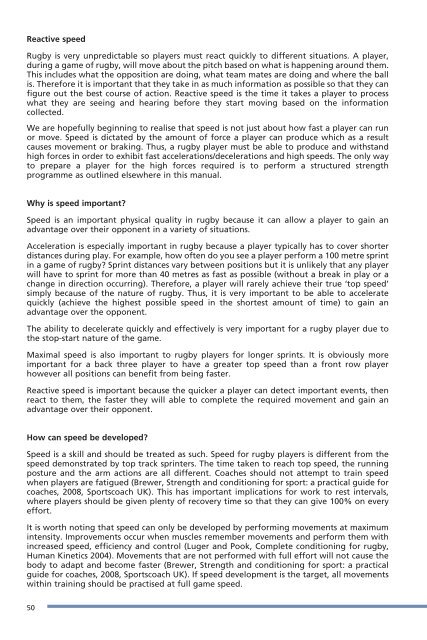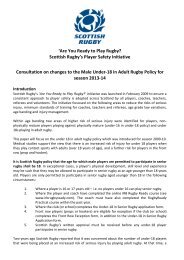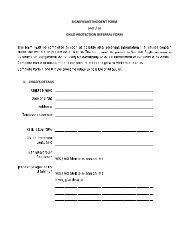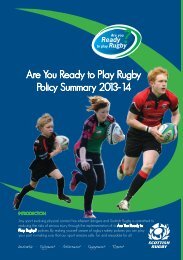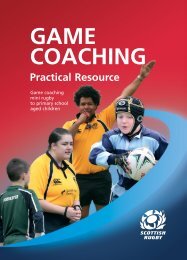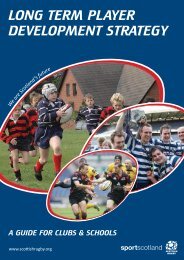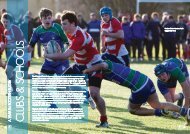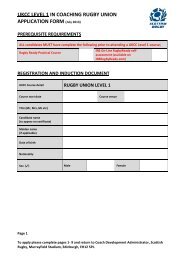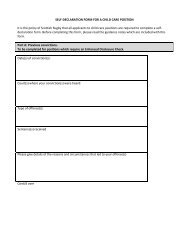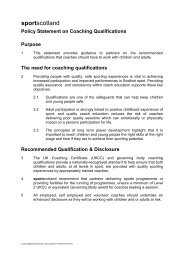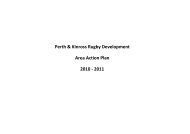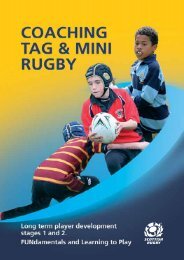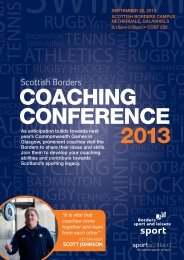LTPDst3cover.qxd (Page 1) - Scottish Rugby Union
LTPDst3cover.qxd (Page 1) - Scottish Rugby Union
LTPDst3cover.qxd (Page 1) - Scottish Rugby Union
- No tags were found...
You also want an ePaper? Increase the reach of your titles
YUMPU automatically turns print PDFs into web optimized ePapers that Google loves.
Reactive speed<strong>Rugby</strong> is very unpredictable so players must react quickly to different situations. A player,during a game of rugby, will move about the pitch based on what is happening around them.This includes what the opposition are doing, what team mates are doing and where the ballis. Therefore it is important that they take in as much information as possible so that they canfigure out the best course of action. Reactive speed is the time it takes a player to processwhat they are seeing and hearing before they start moving based on the informationcollected.We are hopefully beginning to realise that speed is not just about how fast a player can runor move. Speed is dictated by the amount of force a player can produce which as a resultcauses movement or braking. Thus, a rugby player must be able to produce and withstandhigh forces in order to exhibit fast accelerations/decelerations and high speeds. The only wayto prepare a player for the high forces required is to perform a structured strengthprogramme as outlined elsewhere in this manual.Why is speed important?Speed is an important physical quality in rugby because it can allow a player to gain anadvantage over their opponent in a variety of situations.Acceleration is especially important in rugby because a player typically has to cover shorterdistances during play. For example, how often do you see a player perform a 100 metre sprintin a game of rugby? Sprint distances vary between positions but it is unlikely that any playerwill have to sprint for more than 40 metres as fast as possible (without a break in play or achange in direction occurring). Therefore, a player will rarely achieve their true ‘top speed’simply because of the nature of rugby. Thus, it is very important to be able to acceleratequickly (achieve the highest possible speed in the shortest amount of time) to gain anadvantage over the opponent.The ability to decelerate quickly and effectively is very important for a rugby player due tothe stop-start nature of the game.Maximal speed is also important to rugby players for longer sprints. It is obviously moreimportant for a back three player to have a greater top speed than a front row playerhowever all positions can benefit from being faster.Reactive speed is important because the quicker a player can detect important events, thenreact to them, the faster they will able to complete the required movement and gain anadvantage over their opponent.How can speed be developed?Speed is a skill and should be treated as such. Speed for rugby players is different from thespeed demonstrated by top track sprinters. The time taken to reach top speed, the runningposture and the arm actions are all different. Coaches should not attempt to train speedwhen players are fatigued (Brewer, Strength and conditioning for sport: a practical guide forcoaches, 2008, Sportscoach UK). This has important implications for work to rest intervals,where players should be given plenty of recovery time so that they can give 100% on everyeffort.It is worth noting that speed can only be developed by performing movements at maximumintensity. Improvements occur when muscles remember movements and perform them withincreased speed, efficiency and control (Luger and Pook, Complete conditioning for rugby,Human Kinetics 2004). Movements that are not performed with full effort will not cause thebody to adapt and become faster (Brewer, Strength and conditioning for sport: a practicalguide for coaches, 2008, Sportscoach UK). If speed development is the target, all movementswithin training should be practised at full game speed.50


